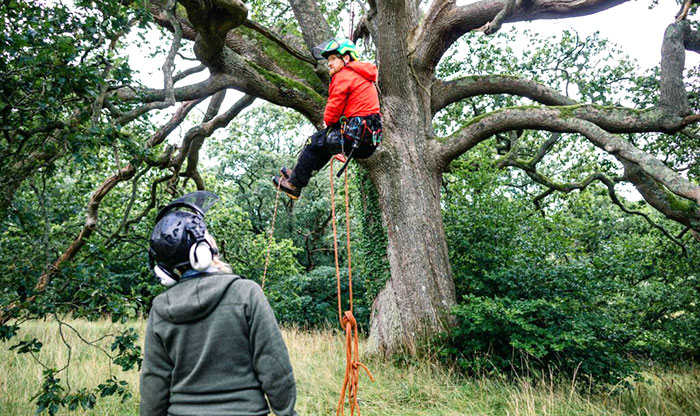If you climb trees for a living or are planning to learn tree climbing as a hobby, then learning technical tree climbing is a must. It may be difficult, as it requires patience to practice and master, but it is very rewarding if you acquire tree climbing skills.
But which method is recommended for climbing a tree? There are two basic methods of climbing a tree using a rope: the moving rope system (MRS) and the single rope technique. MRS is simpler and safer, especially for those learning technical tree climbing.
Contents
The Moving Rope System
Formerly known as the double-rope technique, the moving rope system is a fall protection system where a rope adjustment device can advance along a moving line. This method has been in the climbing industry for ages.
In this system, the climbing line goes over a tree branch through a union or a friction saver. Then, this climbing line will go up and down when the tree climber ascends or descends. Please note that the end of the climbing line is located at the front of the tree climber, where both sides of the rope are moving.
If you are using the moving rope system will lift half of the climber’s body weight, which is considered an advantage. So, if you ascend 10 feet, you will move 20 feet of rope in the rope system, which is literally half the weight, twice the rope length.
However, if you are working in limb walks or canopy, you can use the advantage of this system to slack easily. In addition, using a friction saver can help in reducing friction while increasing the efficiency and saving the wear and tear effect of the rope.
Equipment Used for Moving Rope System
A moving rope system is composed of a climbing line where the end will be used to tie a Blake hitch to the opposite side of the rope. From this initial setup, you can have the option to add hitch-tending pulleys, prusiks, or split tails to make various friction hitches.
Furthermore, this traditional system for tree climbing can also work with a fully mechanical device. When you are using a moving rope system, there will be so many options that you can do in pairing with a mechanical device.
For example, using an eye and eye prusik and oval-shaped carabiners together with the DMM hitch climber pulley can create one of the best rope or rope climbing systems you can use. You can also use other mechanical devices in the market to build a moving rope system around a mechanical device. The choice of device will depend on your preference.
Lastly, when running the moving rope system, it is essential to note that the tree carries the full percentage of the climber’s body weight when ascending or descending. This situation is the same when you throw over a rope with 100 lbs of weight attached to the other end, where you need to use the same weight on the other side to keep the weight elevated off the ground.
The Single Rope Technique
This type of technique will have the climber climb in just one part of the rope while the rope is stationary. This type of system has rapidly gained popularity for tree climbers in recent years because of the benefits it provides.
The Single Rope Technique’s ascending can be very quick and lift the entire body weight with a 1:1 ratio. Meaning, if the climber ascends 20 feet, the climber will only be moving 20 feet of the rope. It will be much easier to ascend in this climbing system, but you will have a disadvantage when making horizontal or vertical moves or limb walking in a tree.
Two Ways to Create Tie-in Points
There are two ways to create tie-in points; the basal anchor or the canopy anchor. In the basal anchor, you will launch the throw line and pull the rope into the tree. Then, you can tie a basal anchor on one side of the rope and into the tree.
Then you can tie the basal anchor to one side of the rope using a purposely built anchor or running bowline with backups. With the basal anchor, you have the ability to increase the load in the tie-in point since one side of the rope is secured.
On the other hand, the canopy anchor can be created the same way as we make the tie-in point of the moving rope system. You isolate the climbing rope using an alpine butterfly, passing the working end and pulling the rope, sending the knot up easier to the tie point.
Conclusion
If you want to know which method is recommended for climbing a tree, there is the moving rope system and the single rope technique. The former is one of the oldest rope climbing systems, while the latter has increasingly gained popularity with its effectiveness. Which systems are the best for you depends on your preference, but having both systems available can help in certain situations.

